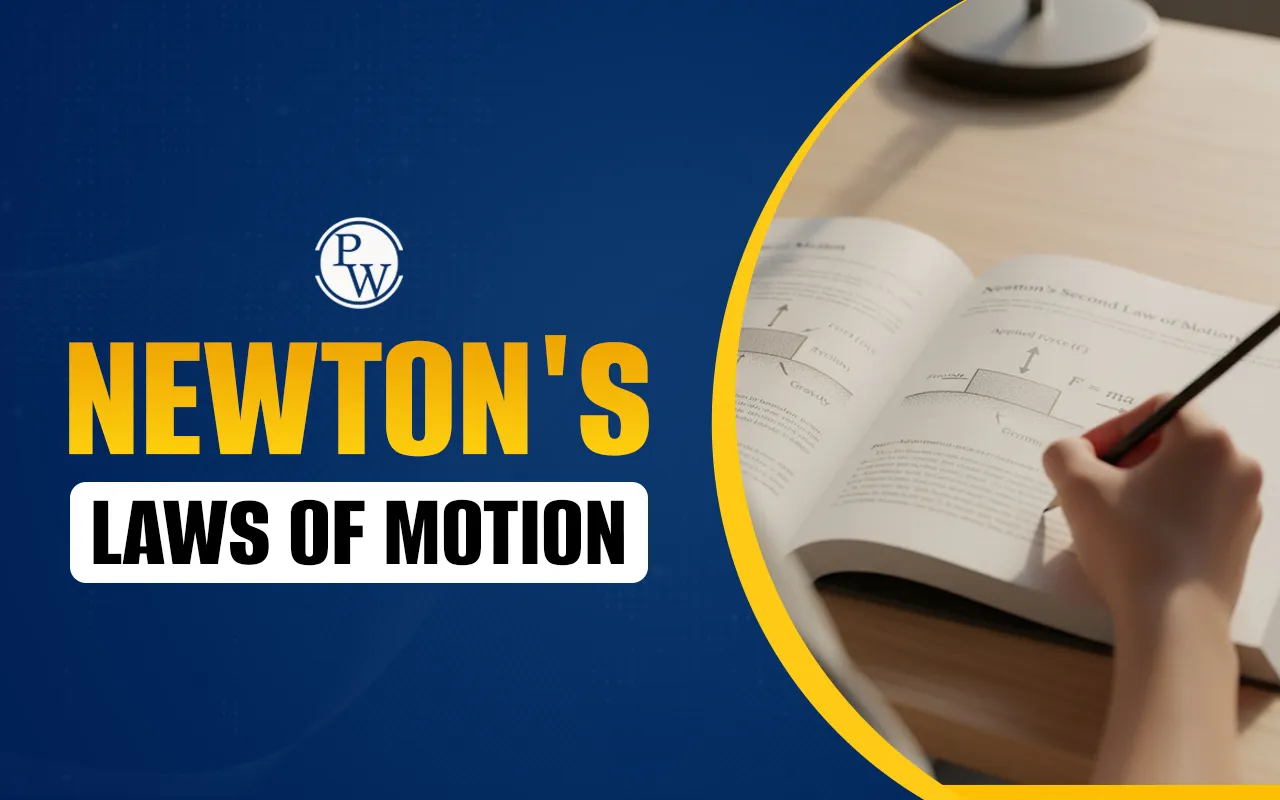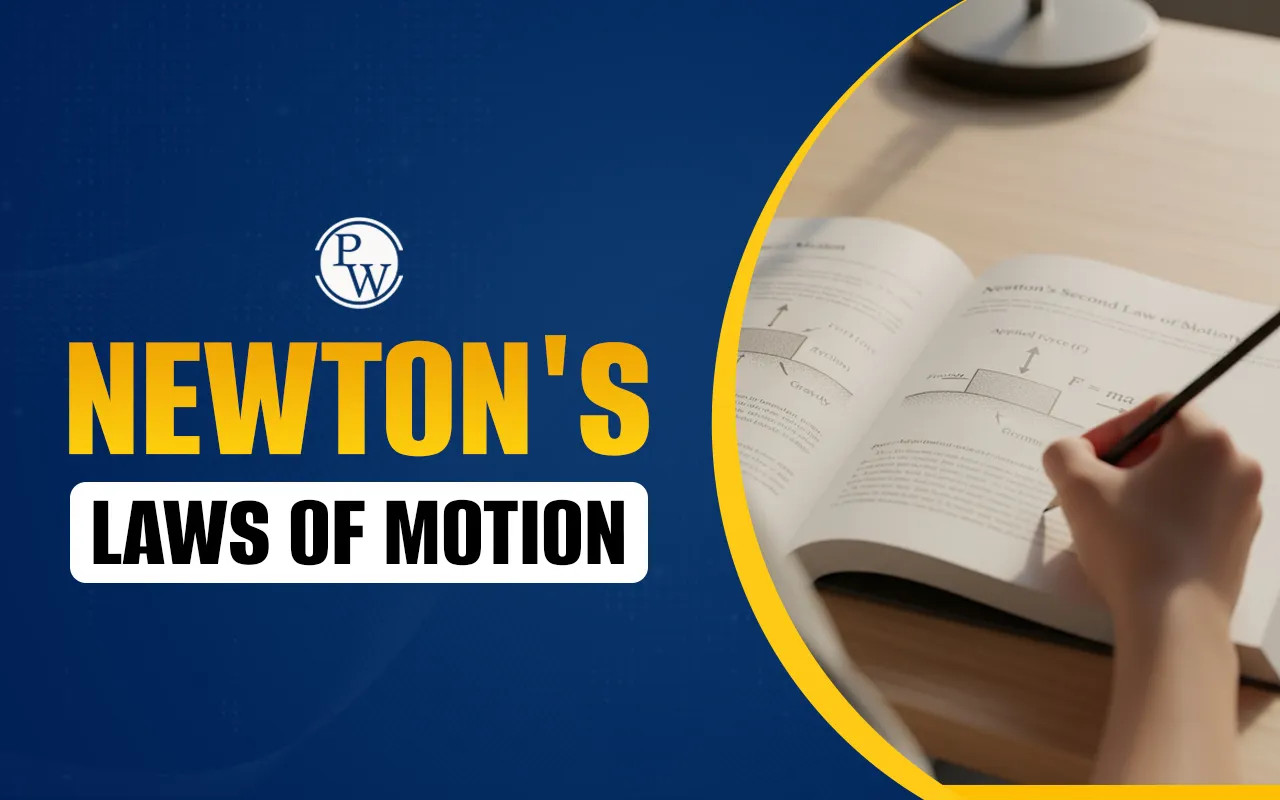

Newton's Laws of Motion form the foundation of classical mechanics and are important for understanding the behavior of objects under the action of forces. These laws, formulated by Sir Isaac Newton, describe how objects move, how forces affect their motion and the relationship between force, mass, and acceleration.
For JEE aspirants a strong grasp of these laws is crucial, as they form the basis for solving a wide range of problems in mechanics, from motion in one dimension to complex systems involving multiple forces. Mastering these concepts not only helps in scoring well but also builds a solid understanding of physical principles that apply to real-world scenarios.
Newton's Laws of Motion Overview
Newton’s Laws of Motion form the foundation of classical mechanics and explain how forces govern the motion of objects. The chapter begins with the concept of Force, which is any influence that can change the motion of an object.
It then introduces Inertia, the tendency of an object to resist changes in its state of motion. Building on these ideas, Newton’s First Law of Motion states that an object will remain at rest or continue in uniform motion unless acted upon by an external force. Understanding these fundamental concepts is important for analyzing motion and solving a wide variety of problems in JEE Physics.
Force
A force is any push or pull that changes or tends to change the state of rest or uniform motion (constant velocity) of a body. Effects of a Resultant Force: When a non-zero resultant force acts on a body, it may produce the following effects:
-
Change the speed of the body.
-
Change the direction of motion.
-
Change both speed and direction of motion.
-
Change the size or shape of the body.
Units for Measurement of Force
|
Units for Measurement of Force |
||
|
System |
Unit |
Other Units |
|
MKS |
Newton (N) |
kg–wt or kg–f (kg–force) |
|
CGS |
Dyne |
g–wt or g–f |
Inertia
Inertia is the property of a body that resists any change in its state of motion or rest. The mass of a body is a measure of its inertia the greater the mass, the more it resists changes in motion.
Types of Inertia:
-
Inertia of Rest: A body at rest resists being set into motion.
-
Examples: Passengers fall backward when a bus starts suddenly; mangoes fall when a branch is shaken.
-
Inertia of Motion: A body in motion resists changes to its uniform motion.
-
Examples: Passengers lean forward when a bus stops suddenly; a running athlete’s speed adds to their jump distance.
Newton's First Law of Motion
Newton’s First Law of Motion states that an object will remain at rest or continue to move in a straight line with uniform speed unless acted upon by an external force. This law essentially describes the concept of inertia, showing that a body resists changes in its state of motion.
Key Points:
-
A body at rest stays at rest; a body in motion stays in motion with constant velocity unless a net force acts on it.
-
The law explains why seatbelts are necessary in vehicles: they prevent passengers from continuing in motion when a vehicle stops suddenly.
-
It applies to all objects, regardless of size or mass, but the effect is more noticeable in objects with larger inertia (mass).
Examples:
-
A stationary ball will not move unless kicked.
-
A moving train continues forward unless brakes are applied.
-
Objects inside a moving bus tend to fall backward when the bus starts suddenly.
Impulse Momentum Theorem
The Impulse-Momentum Theorem states that the impulse applied on a body is equal to the change in its momentum. Impulse is the product of the force applied and the time duration for which it acts, and is a vector quantity.
This theorem is fundamental in analyzing collisions, explosions, and other short-duration forces where momentum changes rapidly. It helps in calculating average forces during impacts, such as a bat striking a ball, a car hitting a wall, or a bullet fired from a gun.
Understanding this theorem is crucial for solving both numerical and conceptual problems in JEE Physics, especially those involving motion, collisions and force-time relations.
Static and Kinetic Friction
Friction is a force that resists the relative motion between two surfaces in contact. Static friction acts on a body at rest and prevents it from starting to move, adjusting itself according to the applied force until motion begins.
Once the body starts moving, kinetic friction takes over, opposing the motion and acting constantly as the body slides.
Apparent Weight in Lift
Apparent weight refers to the normal force experienced by a person or object that is inside a moving-lift, elevator, or escalator. The sensation of weight depends on how the lift is accelerating: If the lift is accelerating upward, the apparent weight becomes greater, so the person feels heavier; if the lift is accelerating downward, the apparent weight decreases, and the person feels lighter than they normally would.
When either the lift moves with a constant velocity or is at rest, the apparent weight is equal to the true weight. This idea is significant in JEE Physics because it can help you understand forces and forces in non-inertial frames, and is helpful for many problems involving escalators, elevators, or acceleration in cars.
Conservation of Linear Momentum
The law of conservation of linear momentum states that the total linear momentum of a system of interacting bodies will remain constant if there is no interaction with an external force. Therefore we expect in every collision, explosion, or interaction between things that the combined momentum of the objects before equals the combined momentum after the interaction.
Momentum is a vector so direction, as well as magnitude, is an important aspect of applying this law.
This law is very useful and simple to apply in solving problems regarding elastic and inelastic collisions, the recoil of guns, the motion of rockets, and exploding bodies. The law allows us to study the motion of objects where forces only act internally and thereby we can make calculations without considering the actual forces present when the two (or more) objects interact.
This law is a fundamental concept in understanding physics and for gaining a thorough understanding of mechanics for JEE Physics, particularly for those problem types that ask about momentum, collisions, and recoil.
Banking of Roads
Banking of roads is the process of tilting the surface of a curved road at an angle to assist vehicles in negotiating the curve safely. When a vehicle traverses a banked curve, the normal force (the force the road platform exerts on the vehicle) provides a component of force acting toward the center of the circular motion (the curve), which causes the vehicle to turn and reduces the need for reliance of the force of friction on the road.
This permits the vehicle to maintain a speed even in the absence of friction (that is, a frictionless road) by balancing the required centripetal force directing it toward the center of circular motion. Banking of roads is a significant principle in JEE Physics, as it assists solving problems which require differentiating between motion on curved paths or incline planes or via circular motion, while it illustrates how force can be resolved to prevent skidding.
Free Body Diagrams
A Free Body Diagram (F.B.D.) is a diagram that represents all external forces acting on an object of interest. To create an F.B.D., the first step is to select the object of interest and then identify all external forces acting on it (e.g., applied force, friction, tension, normal force, gravity). The forces are depicted as arrows pointing in the direction of the force. F.B.D.s are crucial in mechanics problem solving because it allows you to systematically apply the laws of Newton.
For example, if two bodies of masses m and M rest in contact on a smooth floor and a force F is applied on M, the F.B.D. of each body separately will show the applied force, normal reaction between the bodies, and any other relevant forces helping to calculate acceleration and interaction forces.
Friction and Static Friction
Friction is a resistive force that opposes the relative motion or tendency of motion between two surfaces in contact. It acts parallel to the surface and arises due to either the interlocking of surface irregularities (old view) or intermolecular forces at points of contact (modern view).
Friction depends on the actual area of contact and the normal force pressing the surfaces together. Static friction acts when a body is at rest, preventing motion from starting. Its magnitude adjusts itself according to the applied force up to a maximum value called limiting friction, beyond which the body starts sliding. This force is self-adjusting in direction and magnitude, making it crucial for problems involving inclined planes, pulling forces and equilibrium in JEE Physics.
Dynamics of Circular Motion and Conical Pendulum
In circular motion, the linear acceleration of a particle can be resolved into radial (centripetal) and tangential components. The radial acceleration points towards the center of the circle and is responsible for changing the direction of velocity, while the tangential acceleration changes the speed of the particle. In uniform circular motion, tangential acceleration is zero, so the net force acts entirely in the radial direction called the centripetal force.
This centripetal force that acts on an object can be provided by real forces such as tension, friction, weight or normal reaction, depending on the situation.
A conical pendulum is a well-known example whereby a particle which is attached to a string, swings in a horizontal circle. The vertical component of tension balances weight and the horizontal component provides the necessary centripetal force. Using these force components, one is able to derive the radius of the motion, measure the angular velocity of the motion and determine the time period of the circular motion.
These concepts are extremely important for JEE students, because they will typically encounter problems that involve one of the three types of motion - horizontal circular motion, inclined circular motion or conical pendulum motion - and the ideas help students to analyse the forces acting on the object, calculate acceleration and determine time periods.
Newton's Laws of Motion PDF Download
Newton’s Laws of Motion PDF Download is a well-organized study resource designed to help students revise mechanics concepts quickly and effectively. The PDF includes detailed explanations, derivations, solved examples, and important formulas all in one place, saving time and making preparation more focused. It also covers key JEE topics such as Impulse-Momentum Theorem, Static and Kinetic Friction, motion on inclined planes, circular motion and systems of connected bodies.
By practicing both solved and unsolved problems from the PDF students can strengthen their conceptual clarity and problem-solving speed, making it an ideal resource for mastering theory and numerical problems efficiently.
Newton's Laws of Motion PDF Download
Study without using the internet
